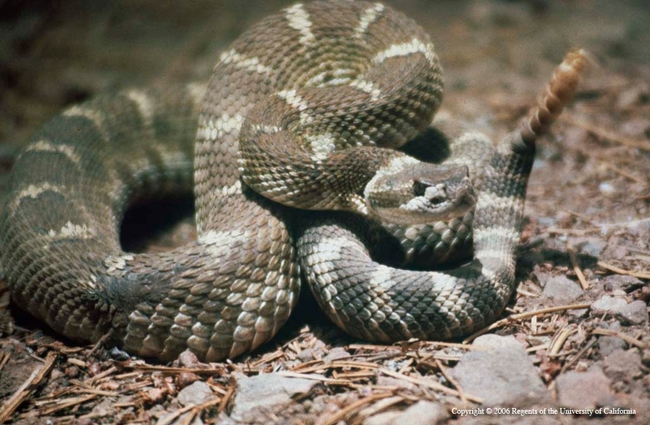Summer is high rattlesnake season for us in California. Classified as a native reptile, the rattlesnake is the only venomous snake in California. At least six species are found in various areas of the state, from below sea level to 11,000 feet. The largest and most common rattlesnake is the western diamondback, found from sea level to 7,000 ft. in southern California. It is also probably the most dangerous, because of its aggressive disposition and size (up to six feet in length). The sidewinder is the smallest of the rattlesnakes; it is also sometimes called the “horned rattler” because of the hornlike scales above its eyes. It is mostly found in desert areas from sea level to 6,000 ft. Speckled rattlesnakes are found throughout Baja California and up the coast to Los Angeles, overlapping with the red diamond rattlesnake in most of that area. The Mojave rattlesnake's range includes the desert and foothills of Southern California from sea level to high elevations. Here in Butte County, we are most likely to encounter the Northern Pacific rattlesnake, which is the Northern California subspecies of the Western rattlesnake.

Rattlesnakes can best be identified by their distinctive triangular head shape. Their rattles are less reliable features for identification because they are often broken off on older snakes. Young rattlesnakes are born with a small rattle or “button.” A new segment is formed each time the snake sheds its skin; since this may occur several times a year, the size of a snake's rattle is an unreliable indicator of age.
Most rattlesnakes forage near brushy or tall grass areas, rock outcrops, rodent burrows, around or under surface objects and sometimes in the open. Adults eat live prey, primarily rodents; young rattlers mostly consume lizards and young rodents. Rattlesnakes wait until their prey is nearby, then strike with two large fangs that inject venom. This subdues the prey, which is then swallowed whole.
Rattlesnakes are called pit vipers because they have small pits on either side of the head between the eye and the nostril. Sensitive to temperature, these pits assist the snake in finding prey. The snake's tongue and nostrils also detect the odors of prey. The venom is produced in glands behind the eyes, and then flows through ducts to the hollow fangs. Normally, the fangs fold back against the roof of the mouth, but when the snake strikes, the fangs are pivoted forward to inject the venom. A dead snake can still inject venom by reflex action for an hour or more after its death.

Be alert during the time of year when rattlesnakes are active: that is from April to October in our region. Rattlers hibernate and hide in rock accumulations and areas where they are protected. Unlike other reptiles, rattlesnakes give birth to live young. To protect their young, rattlesnakes will often give birth in abandoned rodent burrows.
Even though they are dangerous, rattlesnakes are important members of our ecosystem. They add to the diversity of California's wildlife. Remember to be careful when working in your garden or when moving brush or debris in your yard. Always hike with a friend in areas where rattlesnakes may be present. And never, ever, tease a snake.
For more information see UC IPM's Rattlesnakes.
UC Master Gardeners of Butte County are part of the University of California Cooperative Extension (UCCE) system. To learn more about us and our upcoming events, and for help with gardening in our area, visit our website. If you have a gardening question or problem, email the Hotline at mgbutte@ucanr.edu (preferred) or call (530) 538-7201.